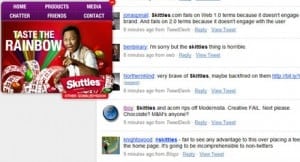
Skittles decided to tap into the growing popularity of Twitter and engage their youth audience with an idea that probably seemed brilliant on a whiteboard. They replaced their usual brand homepage with an automated stream of Tweets from anyone who mentioned their brand name. It was unfiltered, bold, risky … and a huge failure. Predictably, their page was overtaken by social media pranksters who found it funny to release streams of cuss words, brand jokes and generally immature declarations.
It was an embarrassment for the brand, a perfect negative case study for predatory social media gurus and a scary enough backfired campaign that it impacted how all brands looked at the value of Twitter as a marketing channel for a long time. Then Kim Kardashian came along.
Well … to be fair, it wasn’t just Kim. Celebrity after celebrity started flocking to Twitter as an online hotspot to share their 140-character musings with the masses. It was the perfect vehicle to help connect people with little to say with people who had little to do. A marriage built for the web. And these masses were growing exponentially. Ashton Kutcher had a highly publicized showdown with CNN to become the first to reach 1 million followers. Celebrities started charging thousands per Sponsored Tweet, and even factoring Twitter into their spokesperson contracts.
For brand marketing teams, Twitter was officially impossible to ignore.
As the platform emerged, several interesting user behaviours of it started to emerge as well. One of the biggest was that people started using keywords tagged with the “#” symbol to aggregate ideas. Over time, these “hashtags” offered an irresistible new opportunity for brands. Finally there was a way to bring multiple conversations about the same topic together … like, for example, people talking about your brand. It was a dream come true for marketers.
So while people started using hashtags in innocent and functional ways – like #FollowFriday (soon shortened to #FF) as a method of suggesting interesting people on Twitter to follow, brands started to consider the opportunities they offered. Unfortunately, it was an opportunity they squandered more often than not. Usually, the missteps come down to one of three big mistakes.
- Selling at the wedding. In a cultural sense, there are some taboos you just don’t break – like trying to sell in the wrong moments. That is true on Twitter as well. One of the highest profile examples of a brand that got this wrong was Kenneth Cole, when they chose to release a tweet during the revolutionary upheaval and fighting in Cairo. Using the hashtag #Cairo, they tweeted “Millions are in uproar in #Cairo. Rumor is they heard our new spring collection is now available online at http://bit.ly/KCairo – KC.” Making it even worse, the tweet was signed “KC” which stood for Kenneth Cole himself. The backlash over a brand that would use a historical and serious event like this (where people were actually dying) to promote a sale was severe. The brand had to retract and offer apologies, but the damage was done.
- Winking in the dark. Perhaps the most common brand problem is using a hashtag without a reason or rationale for why anyone else would want to use it also. The end result becomes a bit like winking at someone in the dark – you know what you’re doing but no one else does. Without a clear idea of why a hashtag exists or why someone might want to use it to join a conversation, the effort of using a hashtag at all is completely wasted. The vast majority of self serving hashtags that brands often use fit into this category … with a collective result of web-wide indifference.
- Joining the wrong conversation. Sometimes a hashtag can be so common that it might already be in use. Not checking for existing memes can lead to embarrassing results … as bakery brand Entenmann’s learned in 2011. They posted the relatively harmless tweet “Who’s #notguilty about eating all the tasty treats they want?” Unfortunately, that same #notguilty hashtag was also currently being used by people who were following the murder trial of Casey Anthony, a mother who was accused of killing her 2 year old daughter. The jury’s #notguilty verdict causes a huge controversy. The brand, of course, pronounced that its association with the trial was a mistake, and not an attempt to make a statement.
Clearly, using hashtags can be a minefield for brands when done incorrectly. So how can your brand use the power of hashtags without the danger of a high profile mistake? Here are three potential strategies for how to effectively use hashtags as a part of your integrated digital marketing strategy – as well as some examples of brands or organizations who used them.
Strategy #1 – Create an everlasting conversation.

Strategy #2 – Offer a compelling incentive.

Strategy #3 – Take an unconventional viewpoint.
One of the favourite pasttimes of people with too much time on their hands has become sharing the minute details of their lives on a play by play basis … and there is no better social media platform for that type of pontificating than Twitter. Unfortunately, it also leads to regrettable memes defined by hashtags that never seem ready to go away. One of the most popular you may have seen was #firstworldproblems – a joking reference to the fact that people often complain about problems that are not really problems. That hashtag in particular led an inventive advertising team supporting WaterisLife.com to create a video with Haitian citizens reading ridiculous tweets complaining “my house is so big I need 2 wireless routers” and “my mint gum makes my ice water taste too cold.” The end result was a reminder to anyone watching of what really matters … and how much of a difference a small donation can make.
The bottom line is, hashtags can be a missed blessing when it comes to marketing. There are clearly as many pitfalls in using them as there are great opportunities. Luckily, there is a growing number of brands realizing real value from using hashtags by getting creative, using incentives, and finding a way to focus on broader conversations. As with most marketing, whether you’re using social media or not, the same basic rule applies. #strategymatters
NOTE: This blog post was originally published on Popditto as a featured contribution. See the original here: http://popditto.com/2013/06/using-the-hashtag-to-create-cohesive-campaigns/







WE RECENTLY REMOVED COMMENTING - LEARN WHY HERE >